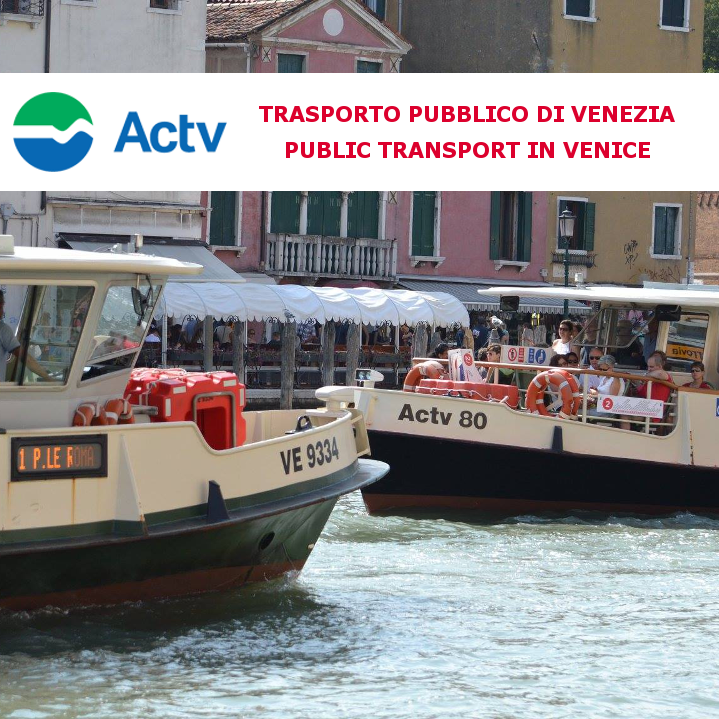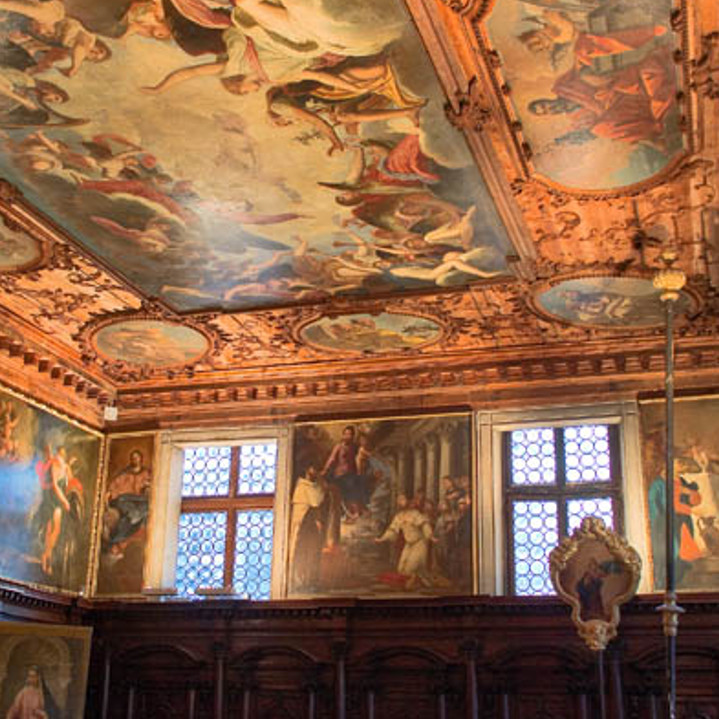You are here
San Polo
Starting from Piazzale Roma with the new Ponte della Costituzione (Calatrava, 2008) over the Grand Canal on your left, cross one of the two bridges over the Rio Nuovo canal (opened in 1938). Cross the Giardini Papadopoli, the park created in 1834 to a design by Francesco Bagnara (modified in 1863) on an area once occupied by the La Croce monastery demolished in 1810. Originally much larger, it was made smaller when the Rio Nuovo canal was opened in 1932-33. Among the trees on the left there is a monument to Pietro Paleocapa (1788-1869), illustrious hydraulic engineer.
On the right looking out over the gardens is the façade of the late 16th century Palazzo Foresti–Papadopoli, famous for the nocturnal parties once held there and for the garden packed with exotic plants and flowers.
Cross the gardens to Ponte dei Tolentini. On your right you can admire the 18th century Palazzo Condulmer (no. 251) with its semicircular pediment, once owned by the family of Pope Eugene IV elected in 1431. On the other side of the bridge stands the Church of San Nicolò da Tolentini (the Tolentini were the Theatines, the religious order founded in 1524 by Giovanni Pietro Caraffa – then Pope Paul IV – and Saint Cajetan di Thiene. After the Sack of Rome, they took refuge in Venice).
Opening out onto Campazzo dei Tolentini is the entrance to the former Monastery of the Tolentini, now occupied by the Venice University of Architecture (IUAV). The door is aremarkable work of contemporary architecture constructed in 1985 to a design by Carlo Scarpa (1906-1978).
Now proceed along Calle de Ca’ Amai, cross Ponte delle Sechere and continue down the alleyway with the same name and Calle delle Chiovere (the chiovere were the areas where the wool cloth was left to dry after dyeing) as far as Campo San Rocco. On the left stands the Church and Scuoletta of San Rocco (the first building constructed here by the confraternity). On the right is the Scuola Grande di San Rocco, begun in 1546 to an initial design by Bartolomeo Bon, later completed by Sante Lombardo and finally Scarpagnino.
From Campo San Rocco you can admire the imposing Basilica of Santa Maria Gloriosa dei Frari, whose main façade looks out over the Campo dei Frari on the side flanked by the canal with the same name. To reach this square, go down the side of the church itself.
Campo dei Frari: lining this vast square are a number of buildings formerly occupied by various religious confraternities known in Venice as "scuole", including (at no. 2998) the Scuola della Passione (1593), once the most important religious congregation after the six "Scuole Grandi". Alongside the façade of the Frari Church is the State Archive and Veneto Archive Superintendency housed in a former Franciscan monastery with a 19th century façade by Lorenzo Santi.
To continue in the direction of Rialto Bridge, we recommend going down Calle Larga Prima near the left transept of the Frari Church, lined on the left with overhanging buildings resting on typical barbacani supports, then continuing either to the right or left down Calle dei Corli (corlo = spinning wheel) and turning respectively left into Calle del Mandoler (almond seller) or right into Calle dei Calegheri (shoemakers) as far as the rectangular Campo San Tomà (Saint Thomas) with on one side the former Scuola dei Calegheri and on the opposite side the Church of San Tomà.
Turn left, cross Campiello San Tomà, follow the fondamenta (quayside) with the same name and after Ponte San Tomà, turn down Calle dei Nomboli (named after the hindquarters of beef displayed by a butcher in the past). From the bridge, to the right you can see the canal-side façade of the 15th century Palazzo Centani, whose main entrance with its attractive Gothic portal is at no. 2793 in the alleyway to the right.
At the end of the alleyway, turn left into Rio Terrà dei Nomboli then right into Calle dei Saoneri (soap makers) and continue as far as Ponte di San Polo Under different names, this important canal represents the boundary between the districts of San Polo and Santa Croce from south to north. From the bridge, rebuilt in 1775, you can see the fine canalside façade of Palazzo Corner Mocenigo on the left and on the opposite side, the original in-view brick façade of Palazzo Moro Lin (15th-16th century), with architectural elements belonging to different periods.
Cross the bridge and continue along Salizzada San Polo with, on the right, the bell tower of the church of the same name and on the left after Calle and Corte del Cafetier, the Oratory of the Crocifisso, incorporated in the Church of San Polo (Saint Paul Apostle).
The apse of the church looks out over Campo San Polo, the largest in the city. It owes its semicircular shape to the winding course of the canal (filled in during 1761) which once flowed near the group of buildings defining the eastern boundary of the square opposite the church.
The square's generous proportions make it the perfect place for events and performances, such as the open air cinema held there during the summer, or particular events during the Carnival period. In the past, the square was often used as a venue for traditional festivals, religious ceremonies and theatrical performances and as a second market place.
Paintings portray the "bull hunts" held in the square during certain city festivities.
Construction of the series of buildings closing the east side of the square began in the 15th century, one of the most important periods for Venetian Gothic civil architecture. Before the canal was filled in, the buildings were connected to the square by private bridges.
Particularly worthy of note at no. 2128 is the imposing Palazzo Corner, now headquarters of the Guardia di Finanza (the "finance police"), built by Michele Sanmicheli in the mid- 16th century.
On the east side at no. 2177, you can admire the early 16th century Palazzo Donà with its pointed-arch portal dating from the 14th century. Numbers 2170-71 and 2169 are represented by the two Palazzi Soranzo, remarkable examples of Gothic architecture.
The first is from the beginning of the 15th century and incorporates 14th century architectural elements, including the architraves of the two portals. The second dating from the mid-15th century is characterised by decorative Flamboyant Gothic motifs, such as the fine balcony on the 1st floor.
At no. 1957, Palazzo Maffetti-Tiepolo is a late 17th century reconstruction attributable to Domenico Rossi of a 14th century building whose plan it retains. Finally, at no. 1991 you can admire an elegant Renaissance building with a Lombard-style corner mullioned window.
Leave San Polo along Calle della Madoneta. Crossing the bridge, you come to Campiello dei Meloni characterised by, on the right, characteristic Gothic style houses with overhanging façades resting on barbacani. Particularly worthy of note on the corner with Calle Larga della Malvasia, a rare example of a medieval block consisting of three independent houses.
On the left a board displays photographs by the photographer Zago depicting the collapse of the San Marco bell tower in 1902.
At the end of Campiello dei Meloni, cross the canal with the same name, and go down the narrow Calle de Mezo ("middle alley") leading to the evocative Campo Sant'Aponal (Saint Apollinaris), dominated at the end by the bell tower and façade of the Church of Sant'Aponal, now housing the Municipal Archive.
Of Veneto-Byzantine origin and incorporating a three-light section, the top of the bell tower was modified in 1467 with the addition of an octagonal tambour with sloping roof.
The magnificent restructured building on the left of the church at no.1252 was once seat of the Scuola dell’Arte dei Tajapiera (confraternity of stonecutters). Decorated at the top by a relief depicting four saints, it incorporates part of the original portal, reduced to a window, with an inscription engraved on the architrave. The Sottoportico de la Madona on the north side of the square bears wooden inscriptions dating from 1830 commemorating Pope Alexander III's stay in Venice in 1177.
Go down Calle dell’Ogio (dell’Oglio) on the right of the church. With Rio di San Silvestro leading to the square with the same name on your right, follow Rughetta del Ravano, then Ruga Vecchia San Giovanni as far as the Church of San Giovanni Elemosinario.
Turn right into Ruga degli Orefici leading to Rialto Bridge. Before the bridge on the left you come to the Church of San Giacomo di Rialto otherwise known as San Giacometto.
The other two sides of the square on which the church stands are defined by the buildings of the Fabbriche Vecchie. The open ground floor, the Sottoportico del Banco Giro, was once occupied by the tables of the bankers used by the merchants to make their payments by transferring credit in bank books. This service was later provided directly by the government which founded public banks such as the Banco della Piazza (1587) and Banco del Giro (1619).
Surrounded on two sides by porticoes lined by typical bacari (inns) offering refreshment to Venetians and tourists alike, it was once frequented by merchants who gathered there to conclude their business deals.
Against the portico there is a statue of the so-called "Hunchback of Rialto" by Pietro da Salò (16th century), a kneeling figure supporting the stairs leading to the Colonna del Bando from which the "comandador" read the laws and sentences.
Text:






